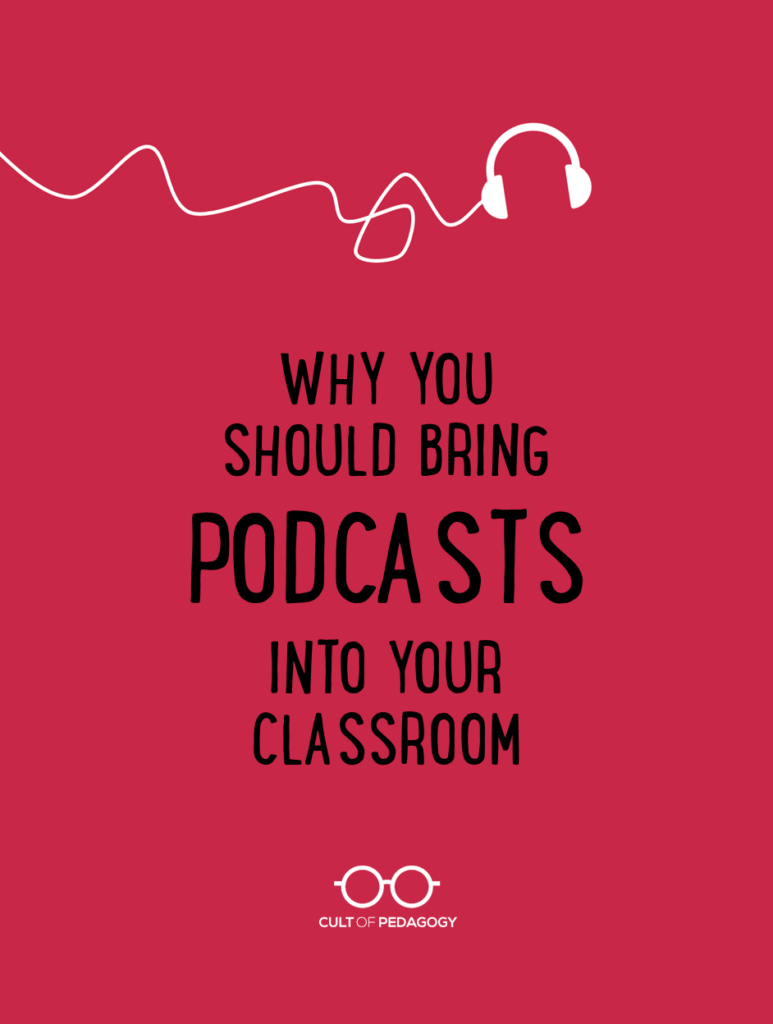
Listen to the interview with Lindsay Patterson, Monica Brady-Myerov,
and Marshall Escamilla (transcript):
Sponsored by Listenwise and Scholastic Scope
This post contains Amazon Affiliate links. When you make a purchase through these links,
Cult of Pedagogy gets a small percentage of the sale at no extra cost to you.
Imagine this scene in your classroom: Students are at their desks, completely engaged and attentive. But no one’s talking. You’re also quiet. Your students are not doing a worksheet. They’re not watching a video. They’re listening.
A podcast is playing from speakers at the front of the room. You can see how your students are caught up in the story. Every so often they laugh at a joke or gasp with surprise at a twist in the story. Their imaginations are alive. The words are turning into movies in their minds. Physically, they’re in the classroom, but really, they’re in another world.
That’s the power of audio. And the best part? Just the act of listening to a good narrative helps your students become better learners. Podcasts are a screen-free, movement-enabling, ear-stimulating and eye-opening way to deliver content. Whether you are in-person, remote, hybrid, flipped or blended, podcasts can enhance your teaching in meaningful ways.
I’ve spent a lot of time thinking and learning about the benefits of podcasts for education. In 2015, I created Tumble Science Podcast for Kids, one of the first educational podcasts for kids. The following year, I helped put together a list of 8 Great Educational Podcasts for Kids for Cult of Pedagogy. I also co-founded Kids Listen, a non-profit organization advocating for podcasts for kids. And now, I’m the CEO of Tumble Media, a production company dedicated to creating children’s educational audio. Through the years, I’ve interacted with teachers who have brought podcasts into their classrooms in incredibly innovative ways. I’ve done in-class demos and have seen students fall in love with podcasts. I wanted to share why using podcasts is so powerful in education. But there hasn’t been a roadmap for how to bring audio into the classroom.
To build that roadmap, I teamed up with Monica Brady-Myerov, the founder and CEO of Listenwise, a platform for improving listening skills through podcasts and public radio stories. She’s one of the pioneers of educational audio and author of the new book, Listen Wise: Teach Students to Be Better Listeners. Monica is an expert on the science of audio, the research behind it, and ultimately, how to use audio to enhance listening and learning.
In this blog post, we share what we’ve learned over years of immersion in educational audio-land, explore why podcasts are so great for education, and provide a roadmap for how to get started. Let’s start with the science.
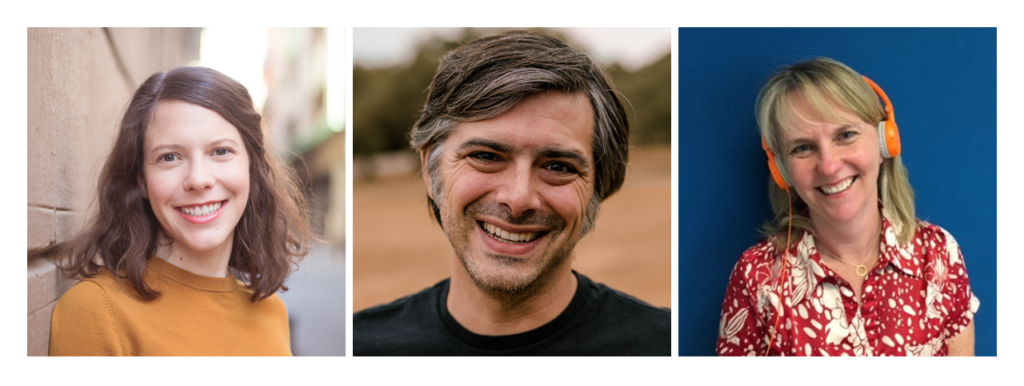
The Science of Listening
We are always listening. And yet a lifetime of hearing doesn’t make us good listeners. We have to work at it. Years of research have proven the benefits of listening in education.
Listening Is a Critical Factor in Learning How to Read
Research tells us that better listeners are better readers. The Simple View of Reading formula developed by Gough & Tunmer shows that reading is a function of two key components: decoding and language comprehension. Listening is a key part of language comprehension. In the science of reading, the awareness of sounds that make up spoken words is critical. Listening to stories helps students hear grammar and syntax and understand how stories work. Incidental exposure to vocabulary through listening and reading together helps students learn the meaning of unknown words. Research shows listening while reading improves text reading rates and leads to higher comprehension.
As students get older, the importance of listening to reading doesn’t disappear; it increases. Researchers found that, over time, the relative importance of listening comprehension increases as a child becomes a more proficient reader. Decoding is still important to reading comprehension, but it’s less of a potential roadblock once kids have mastered it. In fact, by 8th grade, literacy researcher Tiffany Hogan says “all of the reliable variance in reading comprehension could be explained by the listening comprehension factor.”
In other words, introducing more listen-only content will benefit reading comprehension for years to come.
Listening Shapes Your Brain and Memory
Our brains make a mental imagery —the “movie in our minds”—of what we hear. When we listen, our ears aren’t just passive absorbers of information. We are activating systems in the brains that are responsible for sight, sound, motor control and olfaction. “We imagine sounds using the same brain regions that allow us to hear real sounds,” says cognitive scientist Benjamin Bergen.
Listening improves social-emotional wellbeing. Researchers found that when someone is engaged in a story, it’s positively associated with psychological safety and negatively associated with social anxiety. And that connection actually improves your listening.
Listening Supports Multilingual Learning
For the English learners in classrooms, listening provides an equal opportunity to access content and hear authentically spoken language. While listening can occur at different speeds to improve comprehension, everyone is listening to the same text. Unlike reading exercises in which the text is leveled down to the reader’s ability, listening—with the right scaffolding—has the same high level of academic language and content vocabulary.
In addition to learning about the world, listening is an excellent way to build background knowledge of the subject, a key element of listening comprehension, especially in learning a second language.
Why Podcasts Make a Great Addition to Your Classroom
Let’s be honest: Audio has been lifting its weight in the classroom for decades in various forms. But podcasts have unique advantages. They feature authentic language, real conversations, and diverse voices. You can choose from a wide variety of topics—everything from stories, to history, to mindfulness, science, music, literature, and more—and some podcasters even make special episodes designed for the classroom. They’re designed to catch the ear and hold attention in a way that feels almost magical. Best of all, podcasts fit any classroom budget: They’re free.
Kids Love Podcasts
Podcasts aren’t a tough sell for kids. They’re a dedicated audience. One in 4 kids already listen to podcasts, according to Ipsos, a global market research firm. At Kids Listen, we found a variety of reasons behind this in our most recent survey of listening families. The top reason was that they are fun and entertaining (49 percent), followed by their educational appeal (33 percent). A host of other reasons included that podcasts build skills, calm kids, prompt family discussion, allow for multitasking, and provide regular new content. In one notable response, a teacher from Texas said, “One of the new TEKS for 4th and 5th graders is LISTENING. We listen most mornings in the classroom. The kids LOVE it.”
When you introduce podcasts to your classroom, ask students if they have listened to podcasts, and which are their favorites. It may give you some ideas of podcasts to check out!
Podcasts are Portable and Mobile
A primary benefit of audio is that it doesn’t tie students to a screen. That opens up a whole range of possibilities for creative educational experiences. This is highlighted by the most recent Kids Listen survey. We asked parents what activities children engage in while listening to podcasts. The majority of respondents (78 percent) responded that kids “just actively listen,” they also did a variety of other things: Playing, working with art materials, getting ready for bed, doing chores, and other elements of their daily routine.
That flexibility at home translates to educational settings as well. Play a podcast while your students do classroom chores or creative activities that don’t require mental focus. Cue up podcasts on their devices while they walk around the school, getting exercise while practicing their listening skills. Or combine podcast time with drawing—students can sketch scenes from the podcast as they listen. The list of things to do while listening is endless.
These ideas work for any podcast. But some podcasts are built around activity.
- Mindfulness podcasts like Peace Out and Like You guide kids through meditation and movement.
- Music education shows like Noodle Loaf and The Music Box encourage making music and moving around.
- On Tumble, we’ve leaned into these audio advantages by designing episodes and audio courses that encourage active exploration. For example, our interactive episode “Solve the Case of The Sleeping Trees” leads students through making observations, asking questions, and making conclusions. The ideal setting to listen is outdoors, in nature.
Podcasts Are a Great Way to Explore Current Events
Most podcasts are designed to be evergreen; you can return to the same episodes year after year, and they’ll still be relevant. But others are designed for the moment.
News podcasts are a great way to approach current events. Typically short, you can play episodes as a warmup for the day, or as a lead-in to larger discussions.
- KidzNuz is designed for the classroom, with a quiz at the end of each daily episode to practice comprehension.
- Published twice weekly, The Ten News clocks in at ten minutes: Each episode tackles the biggest headlines, followed by fun segments and trivia questions.
- Newsy Jacuzzi is an international take on the news, hosted by a mother and daughter in India.
- Listenwise curates daily current events for the classroom and gives you a bank of questions to spark conversation.
It’s not just news podcasts that can help kids process current events and realities. At Your Level, hosted by an 11-year-old kid, did an episode on pandemic birthdays during the coronavirus lockdowns. Even fictional stories can take on elements of real life. For example, in the Stoopkid Stories episode “The BB Twins,” the characters deal with the effects of their dance going viral on social media. Stories can also take on hot topics like The Imagine Neighborhood’s 6-part series on Race, Identity, and Making Things Right.
Podcasts Come in a Variety of Lengths
Not only do podcasts provide a variety of content, they come in a variety of lengths. You can choose whether to make listening your main meal, or simply a side of your lesson.
Many educationally-minded podcast creators have consulted with teachers in order to develop special episodes that fit into classroom time.
- Pamela Rogers, a school librarian and creator of the literature podcast Buttons & Figs, developed playlists of 5 minute interactive wordplay challenges for the classroom.
- What Will She Do Next, a women’s history podcast, creates 10 minute episodes in addition to their usual 20 minute episodes.
- Timestorm, a serialized audio podcast for tweens and teens, creates 10 minute stand-alone minisodes.
- Love Learning, which offers everything from poems to mediations for elementary students, clocks in episodes from one minute to 11 minutes.
Other short podcasts include the serialized fiction podcast Six Minutes, a personal growth podcast Five Minutes with Dad, African Folktales, and Two Whats and A Wow.
Other podcasters have found that 20 minutes is a great length for the classroom. Kitty Felde edits her episodes of Book Club for Kids and her series, The Fina Mendoza Mysteries, to that length based on teacher input. Eat Your Spanish, a language learning podcast, can serve as a full lesson at 20-25 minutes. From personal experience, Tumble’s 15 minute episodes are frequently used in the classroom as well.
Listenwise offers a happy medium by editing longer podcasts and NPR stories into shorter versions. The audio stories are 5 minutes long and come with listening discussion questions, interactive transcripts and quizzes across a wide variety of subjects in ELA, social studies and science.
Podcasts Help You Meet Academic Standards
Aside from the fun benefits, there’s a very practical one too. Listening now is an anchor standard of the Common Core. Even states that are not using Common Core standards include listening in their curriculum standards. Twenty-two states include listening in their high-stakes exam. If you are in California, Wisconsin or Indiana, a portion of your ELA exam is listening.
Practicing students’ listening “muscle” for these tests makes sense, and you can build their listening stamina with a podcast. When they enjoy listening to podcasts, they’ll be strong for the assessment audio. Following listening, asking kids to identify the main idea, make an inference or recall a specific detail from the story also addresses many other ELA standards. And if you listen to a podcast aligned with your curriculum such as an Earth Rangers episode on frogs and metamorphosis, you can also knock off some NGSS science standards.
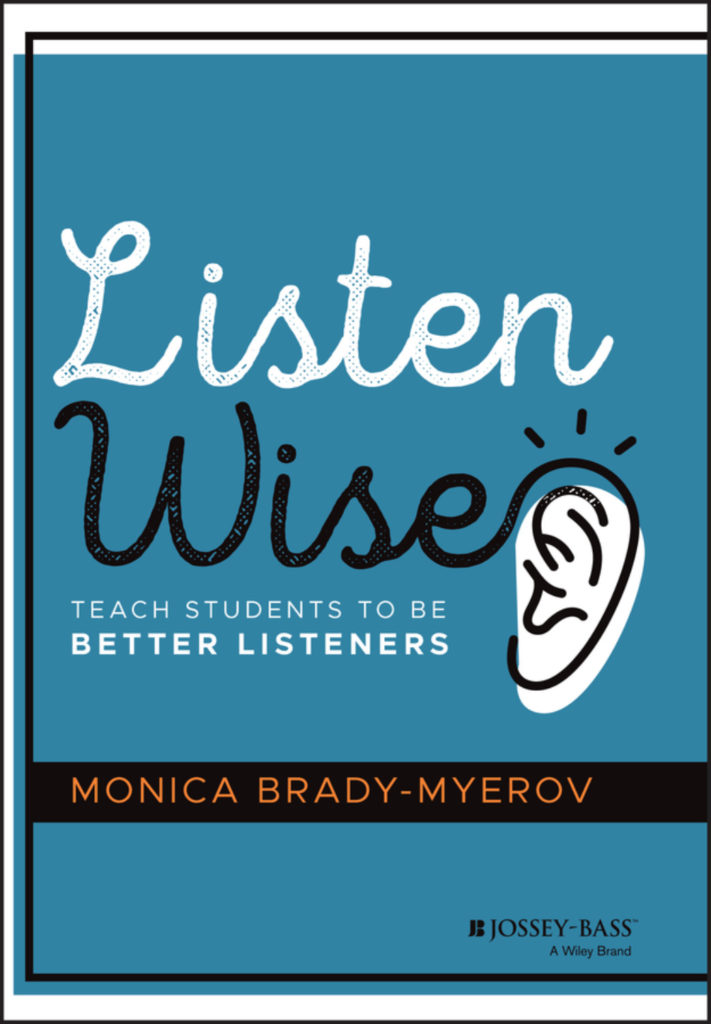
Top 4 Places to Find Audio for Kids
Now that we’ve convinced you that adding audio to your instruction is an easy, fun way to build skills and knowledge, you’re probably wondering where you find all this great audio? We’ve already mentioned a few shows and platforms, but here’s a list of platforms for you to discover your favorite podcasts.
Kids Listen
Kids Listen is a nonprofit organization that advocates for high-quality audio content especially made for kids, with over 130 member podcasts. The Kids Listen App (for iOs, Android, and web browser) organizes these podcasts by age, interest, and curated playlists. The Kids Listen Activity Podcast brings you episodes from different podcasts, paired with suggested activities for further learning. Kids Listen University is a place to find podcast-based lessons and curriculum.
Listenwise
This online platform brings NPR and podcasts to the classroom with easy-to-use podcast lessons and listening comprehension quizzes. The collection of 2500+ curriculum-aligned podcasts for grades 2-12 keep teaching connected to the real world. Free for teachers, a Premium subscription available for schools.
School Library Journal
Librarians Pamela Rogers and Anne Bensfield write a regular column about “Kidcasts,” exploring recommended episodes by themes like “Black Changemakers,” “Podcasts to Encourage Mindfulness,” and “Poetry.” They created this handy poster with their top “classroom-ready” podcasts.
PINNA
A paid subscription for teachers or parents who want ad-free streaming services for kids podcasts ages 3-13. PINNA is quickly producing new podcasts for kids so there is a lot to explore on this platform.
Additionally, I’ve written two kidcast recommendation articles for The New York Times: A Big List of Podcasts for Little Kids and A Big List of Podcasts for Bigger Kids.
More kids’ podcasts are coming out all the time, so keep your ears open. With all these resources, all you need to do is go forth and listen!
Join our mailing list and get weekly tips, tools, and inspiration that will make your teaching more effective and fun. You’ll get access to our members-only library of free downloads, including 20 Ways to Cut Your Grading Time in Half, the e-booklet that has helped thousands of teachers save time on grading. Over 50,000 teachers have already joined—come on in.

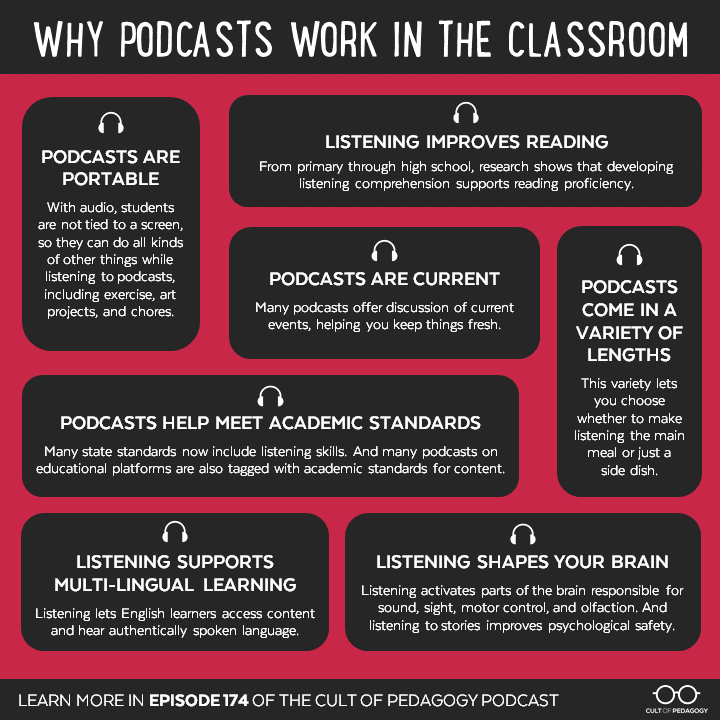

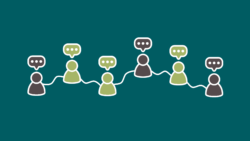


Such an AWESOME episode! Thank you so much for all the amazing ideas and info!! 🙂
I was a Media Studies teacher in a previous life (!970s to 1990s) a millennium ago. One equal facet in a 6 unit Media Studies course for upper secondary students was about radio. It was already in an evolutionary phase because of MTV, then computers and electronic games. For some, the unit was an incredible ear opener. From Marconi to Orson Welles “War of the Worlds” (1938). We even had access to a public broadcaster 6NR (university radio) for which we produced documentaries and rockumentaries. We evened a lunchtime radio station at the school. Ears ruled!
All gone now, but this belly button podcast about podcasts has re-stimulated my ear/brain connections. One side track was your promo of “Listenwise” and where I ended up, was an example about a South Sudanese refugee named Daniel (instant connection) who tells his story in an interview. I am now a retired teacher/tutor and have a student family from the Sudan who need help with English, especially the mother. They, too, are refugees and I now want to share Daniel’s story with them. Small world.
Then I went to the News and Current events library and came across an August 4 story about the first African American student to win a national Spelling Bee competition. I found this to be ideal for a 12 year old girl (same family) to motivate her to work hard to lift her English language skills.
Thank you, thank you, thank you – for your Cult of Pedagogy, for your particular selection of these guests and for your sharing of Listenwise. You have made my day!
Thank you for sharing your experiences, Warren! We’re glad the post was helpful for you. I will be sure to pass on your message to Jenn.
Love this episode! I have been dabbling in using podcasts.
Does anyone have any recommendations for podcasts in Spanish? For example, something like the teacher friendly podcasts listed here, but in Spanish.
Hi Janet! Please check out Tumble En Español – it’s an adaptation of popular Tumble episodes. We plan to produce new episodes soon! Here’s the show: https://anchor.fm/tumbleenespanol
Hi, I love the idea of using podcasts to listen to in the classroom, especially as it enables us to be inclusive of people with sight deficiency. But this takes for granted that people in the podcast talk in the kids’ first language… What if, like me, you’re an English teacher abroad? How do you bring in content through foreign language to English learners being your main “target” (and not just a minority of ELL kids in your English fluent class)? Thanks!
Hi Eva,
That’s a great question! There is lots of research on the benefits of English language podcasts for ELLs for vocabulary, pronunciation, and grammar, in addition to listening. Of course, it all depends on the context. It would be an interesting subject for another post! Check out Duolingo’s podcasts for an approach that combines both the listener’s native language and the language being learned: https://podcast.duolingo.com/
I would love more advice on **how** to best use podcasts in class, especially podcasts that are not already on a built-out site like ListenWise. There are so many wonderful podcasts I would love to have my students listen to, but I am always worried I am not using them as effectively as I could.
Hi Hannah!
There are some suggestions in the section “Podcasts are Portable and Mobile” of this post, but I would also encourage you to think of podcasts as an alternative to a printed text. Students can practice comprehension skills, use stories they listen to as mentor texts for writing inspiration, or choose a podcast as a center activity during independent work time. The possibilities are many!
canI sue that in my maths class
Hi Linday, as a podcast fanatic and masters student working to get my teacher’s certificate, I agree with all your reasons on why teachers should bring podcasts into the classroom. Podcasts are currently en vogue and the amount of educational podcasts themselves are staggering. I myself use Duolingo’s Spanish podcast to improve my listening skills. I listen to financial advice podcasts, history podcasts, science podcasts, etc. I was wondering how you think I should integrate podcasts in a social studies classroom? Are they something students should complete and listen to on their own? Would they work as in class assignments or as part of class discussions? I don’t doubt any of the benefits mentioned in your blog, I’m just curious as to how I could use podcasts for history, let’s say.
Hi Gabriel, you can use podcasts in many creative ways, no matter what subject, and adapt to the age of the students. I’ve heard from teachers who play them in the classroom to listen together and discuss, send them home for assignments, and/or use them as models for students to make their own podcasts. Experiment and see what works.
This is such a great post. I hadn’t considered how freeing it would be to play a podcast and not be constrained by having to see a screen. The information could be delivered and almost become part of a conversation. Plus, they’re much easier to create than video.
Derek, we’re so glad this resonated with you! Happy podcasting!
Thank you for these suggestions! Not only am I going to implement podcasts with my high school English students, but I am going to utilize podcasts with my eight and ten-year-old children to improve their listening skills.
I have used videos a lot in the classroom and the students do not seem very drawn to it. I read this post and tried a mini-podcast about Felix Baumgartner and his space jump and the students were intrigued the entire time. I would love to include more science-based podcasts in my class.
Glad to hear it, Jessica! Let us know how it goes!
Loved the episode! Quick Question–what age group are most of the featured podcasts focused upon? I have used Listenwise in my high school classroom previously, but now I am in a middle school position. So, I’m wondering if any of these podcasts would work (besides Listenwise) without being too babyish for my middle school students. Thanks!
Kirstie, since each podcast is different, the best option is to visit each of the podcast sites for more information. If they don’t specify an intended age range, you should be able to get a good idea by listening to one or two of the episodes for a few minutes. You may also want to Google “best podcasts for teens or middle schoolers” to get some good suggestions. I hope this helps!